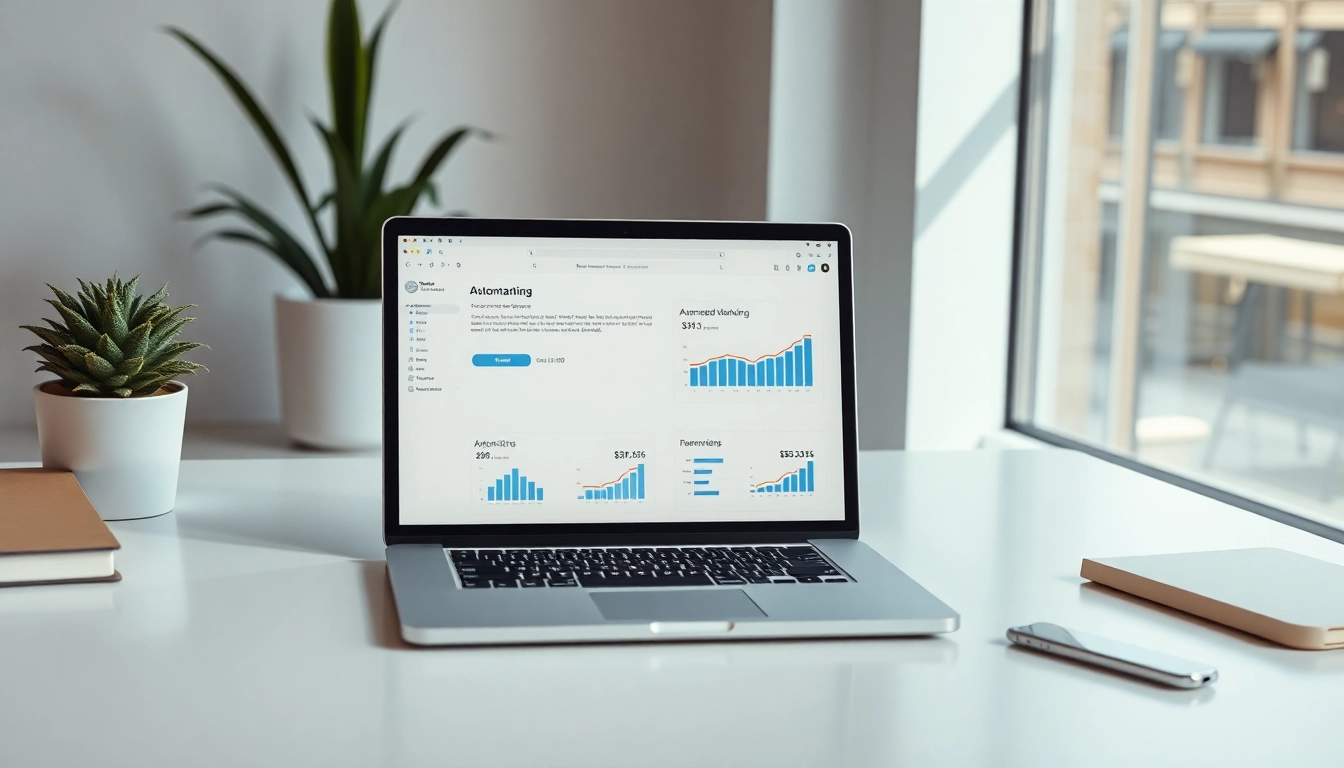Understanding Email Automation Tools
What is an Email Automation Tool?
An email automation tool is a software solution designed to automate various email marketing tasks. It streamlines the process of sending emails, managing subscriber lists, and analyzing campaign performance, allowing businesses to communicate effectively with their audience. By utilizing predefined triggers and workflows, these tools can send personalized emails based on user behaviors or specific timelines, making marketing efforts more efficient and targeted.
Benefits of Email Automation for Businesses
Email automation offers a plethora of advantages for businesses of all sizes. Firstly, it enhances efficiency by saving time; marketers can set up email campaigns to send out automatically, freeing them to focus on strategy and creative aspects. Additionally, email automation helps maintain consistency in communication, ensuring that relevant information reaches the audience without delays.
Another significant benefit is the ability to nurture relationships with leads and customers. Automated follow-up emails can engage users nurturing them through the sales funnel. It also provides businesses with valuable insights into audience behavior, enabling targeted campaigns based on data analytics. By using segmentation, brands can send tailored messages, fostering deeper connections and increasing conversion rates.
Common Features of Email Automation Tools
When considering an email automation tool, several features stand out as essential:
- Templates: Pre-designed email templates for various purposes, saving time while ensuring professional appearance.
- Segmentation: The ability to categorize subscribers based on demographics, preferences, or past interactions, allowing for highly targeted campaigns.
- A/B Testing: Testing different emails to determine which versions perform best and optimizing future campaigns accordingly.
- Analytics and Reporting: Access to performance metrics such as open rates, click-through rates (CTR), and conversion rates to measure success.
- Integrations: Compatibility with other platforms such as CRM software, social media, and e-commerce systems to streamline marketing efforts.
- Autoresponders: Automating a series of emails based on subscriber actions or sign-up sequences.
Choosing the Right Email Automation Tool
Factors to Consider When Selecting an Email Automation Tool
Choosing the right email automation tool requires careful consideration of various factors. Firstly, the size and needs of your business play a crucial role; some tools are tailored for small businesses, while others serve larger enterprises. Consider the pricing structure as well—many tools offer different tiers based on features and the number of subscribers.
Usability is another critical aspect. Look for user-friendly interfaces that your team can navigate easily without extensive training. Make sure to also evaluate customer support options; reliable support can be invaluable, especially during setup or troubleshooting. Furthermore, assess the scalability of the tool. As your business grows, your email marketing needs may change, and your chosen tool should be able to accommodate that growth.
Comparing Popular Email Automation Tools
Several email automation tools are widely adopted across various industries. Tools like Mailchimp, HubSpot, and ActiveCampaign offer robust features that cater to different business needs. Mailchimp is known for its easy-to-use platform and rich analytics, making it ideal for beginners. HubSpot combines email automation with CRM capabilities, making it a great option for companies focused on inbound marketing. ActiveCampaign excels in personalization and segmentation, allowing businesses to send highly targeted communications.
Setting Goals for Email Campaigns
To leverage the full potential of email automation, businesses must establish clear goals for their campaigns. Whether it’s increasing brand awareness, generating leads, or converting sales, having specific objectives helps in crafting tailored content and strategies. For instance, if increasing website traffic is a goal, the email content should include links to relevant blog posts or product pages. Moreover, setting measurable goals—like achieving a specific open rate or click-through rate—can guide optimization efforts in subsequent campaigns.
Setting Up Your Email Automation Campaign
Step-by-Step Guide to Configure Email Automation Tools
Setting up an email automation campaign involves several key steps:
- Define Your Audience: Understand who your subscribers are and what content they value.
- Select Your Tool: Choose an email automation tool that fits your business needs.
- Create Subscriber Lists: Organize your audience into segments for more effective targeting.
- Design Your Emails: Use templates to create visually appealing email designs that align with your brand.
- Set Automation Triggers: Establish the triggers that will send your emails—these could be user actions like subscribing or purchasing.
- Test Your Campaign: Before launching, send test emails to ensure everything functions as intended.
- Launch and Monitor: After launching, monitor performance metrics closely to assess the campaign’s effectiveness.
Best Practices for Successful Email Campaigns
To improve the success of your email campaigns, consider the following best practices:
- Personalization: Use the receiver’s name and tailor content based on their preferences or past interactions.
- Clear Call to Action (CTA): Each email should have a clear CTA that directs the recipient on what action to take next.
- Consistent Schedule: Maintain a consistent sending schedule to keep your audience engaged and anticipating your emails.
- Responsive Design: Make sure your emails are mobile-friendly, as a significant portion of users checks emails on their phones.
- Feedback Loop: Encourage feedback, and use it to refine future communication strategies.
Creating Engaging Content for Automation
Engaging content is at the heart of successful email automation. Start by identifying pain points your audience faces and creating content that addresses those needs. Use storytelling techniques to make your emails more relatable and enjoyable to read. Visual elements such as images and videos can enhance engagement, but ensure that they are optimized for fast loading times.
Additionally, provide value in every email—whether through exclusive offers, valuable insights, or informative content. Creating a sense of urgency with limited-time offers can also stimulate quick responses from subscribers, driving conversions.
Measuring the Success of Email Automation
Key Metrics to Track in Email Automation
To gauge the success of email automation efforts, businesses should monitor various key performance indicators (KPIs):
- Open Rate: The percentage of recipients who opened the email, indicating its subject line’s effectiveness.
- Click-Through Rate: The percentage of recipients who clicked on links within the email, reflecting the relevance of the content.
- Conversion Rate: The percentage of recipients who completed the desired action after clicking through—essential for measuring ROI.
- Unsubscribe Rate: A metric that tracks how many subscribers opted out of your emails, helping identify potential issues in content or frequency.
- Engagement Rate: Combines various interactions (likes, shares, etc.) to assess overall recipient engagement with the brand.
Analyzing Campaign Performance
Regular analysis of campaign performance is crucial for ongoing improvement. Leverage the analytics provided by your email automation tool to identify trends and patterns. Segment your analysis by different audience groups to understand which segments engage better with specific content. If certain emails consistently yield lower open rates, it might be time to reevaluate the subject lines or timing.
Additionally, consider the timing of your emails; analyze data to see if sending emails at different times of the day or week impacts engagement metrics. This allows for data-driven adjustments that improve campaign success over time.
Optimizing Future Campaigns Using Data
Data-driven decisions are vital in optimizing future email campaigns. Use insights gained from previous campaigns to refine segmentation strategies or adjust content to align better with audience preferences. A/B testing is particularly effective for optimizing subject lines, content, and CTAs. Even small changes can lead to significant improvements in performance.
Incorporate customer feedback mechanisms such as surveys or polls in emails to gather insights directly from your audience about their preferences and expectations, further enhancing your future email strategies.
Advanced Email Automation Strategies
Segmentation and Personalization in Email Marketing
Advanced segmentation and personalization go beyond simple demographic categories. Behavior-based segmentation involves categorizing users based on their interaction with previous campaigns, allowing for highly customized content. For example, if a subscriber frequently clicks on newsletter articles related to technology, future emails could focus on tech innovations or products.
Personalization can extend to dynamic content that changes within the email based on the recipient’s traits. Email tools that support dynamic content enable marketers to deliver a unique experience to each subscriber, which can significantly boost engagement and conversion rates.
Integrating AI with Email Automation
Artificial intelligence (AI) is revolutionizing email marketing by introducing predictive analytics, smart segmentation, and automated content suggestions. AI can analyze vast amounts of subscriber data to predict which content will resonate best with specific audience segments. This capability helps marketers craft highly relevant and timely emails.
AI-powered tools can also optimize sending times by determining when each individual subscriber is most likely to engage with emails, maximizing the chances of interaction. Incorporating AI into email automation not only enhances the efficiency of campaigns but also provides a more compelling user experience.
Future Trends in Email Automation Tools
As technology evolves, so do email automation tools. Future trends indicate a greater shift toward integration with social media platforms, allowing for multi-channel marketing approaches. Businesses can reach out to audiences on their preferred platforms while keeping email as a key component of their communication strategy.
Moreover, advancements in machine learning will further enhance personalization and predictive capabilities, making automated campaigns even more effective. As privacy regulations become stricter, email automation tools will need to ensure compliance while still delivering tailored experiences.



